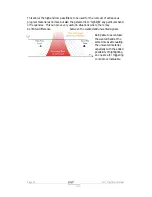
Page 18
G2
Operators Manual
What is the difference between an Expander and a Noise Gate?
In the same way as a limiter can be thought of as a compressor with an infinitely high
ratio, a noise gate is an expander with an infinite ratio. As the expander and noise
gate share similar controls and ultimately work in the same way, consider the burst
diagram below, which demonstrates the action of a noise gate.
As the signal in region
1, is below the
threshold set for the
gate to be ‘open’, the
output will be
attenuated. The
amount of attenuation
applied is not
dependant on a ‘Ratio’
this time, but on the
‘Range’ control setting.
This determines the attenuation in dB’s, which is applied to all signals below the
threshold irrespective of how far below the threshold they are. Whilst the expander
gradually applies attenuation to a greater degree as the signal falls further below the
threshold, the gate will ‘close’ below the threshold applying the number of dB’s of
attenuation set by the ‘Range’ control. If, for example, the threshold is set to 0dB,
and the level drops to –10, if the ‘Range’ is set to 20dB, then the output will be
-30dB: -10 with 20dB of attenuation.
The orange region represents the ‘Attack’ phase of the noise gate, as the signal rises
above the threshold and the gate ‘opens’. The green shaded section is the ‘Hold
Time’ parameter. This has been explained in the earlier section ‘Using the Hold
Time’ in the noise gate section on page 13.
Содержание G2
Страница 1: ......











































